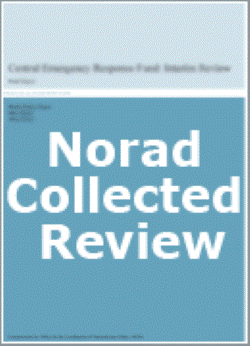Annual review of DFID/RNE Malawi´s Anticorruption bureau support programme
Om publikasjonen
- Utgitt: november 2010
- Serie: Norad-innsamlede rapporter
- Type: --
- Utført av: Hannes Hechler (Chr. Michelsen Institute, Norway) and Bea Parkes (DFID
- Bestilt av: DFID and the Norwegian Embassy in Lilongwe
- Land: Malawi
- Tema: Anti-korrupsjon
- Antall sider: 36
- Serienummer: 9/2010
- ISBN: 978-82-7548-528-9
- ISSN: --

NB! Publikasjonen er KUN tilgjengelig elektronisk og kan ikke bestilles på papir
The Project
DFID has been supporting the Malawian Anti-Corruption Bureau (ACB) since shortly after the inception in 1998. The Royal Norwegian Embassy started its support to the ACB in 2001 and the two donors have since 2007 joined into a funding agreement. The two donors fund the ACB with the equivalent of approximately 7 million USD. The goal of the current phase is ”The elimination of corruption in all its forms in order to enhance the socio-economic well-being of all the people of Malawi”, the purpose is “to prevent and reduce corrupt practice in Malawi”.
The Royal Norwegian Embassy will support the program with NOK 20 million until 2011.
Interesting Findings
- ACB documentation and overall achievement on goals and indicators is satisfactory.
- On the donor side programme documentation needs improvement. Re-organization of DfID’s log frame has not been finalized, resulting in inconsistent indicators and baselines.
- Over the last two years the ACB management has remained stable to positive effect. Government (GoM) commitment to fight corruption is visible, but competes with other interests and priorities. The National Anti-Corruption Strategy (NACS) has been launched, but key processes, such as an implementation plan and secretariat, are not in place yet.
- The ACB has in place a robust staff capacity appraisal and development system.
- GoM approved a new ACB staff establishment, doubling staff over the next 5 years. However, unsecure funding calls for more donor engagement, risking ACB’s independence.
- The ACB still has a strong focus on investigation and prosecution. Little is publicly known about its prevention or education work.
- The implementation of the communication strategy has not progressed well. It lacks responsibilities related to ACB divisions and indicators in the ACB Strategic Plan.
- Despite an increasing number of complaints, the number of complaints with corruption relevance remains at a low level. This points to a gap in bringing key messages about corruption and complaints mechanisms across to the general public.
- The prosecution database has been developed but is not fully operational yet. A senior prosecutor has been employed to take some workload off the ACB director. A prosecution strategy as proposed by the last review has not been developed and is seen as controversial within the ACB.
- 10. The ACB has staff retention problems, most severe in the prosecution division, as the ACB is not in a position to raise their lawyer’s salaries to a competitive level.
- 11. The general public acknowledges the achievements of the ACB, but scepticism lingers of its ability to engage impartially in the fight against corruption.
- 12. The ACB’s performance is affected by a political context where politics and institutions are highly personalized, and a political culture which tends to discourage impartiality, i.e. actions taken are seen to be influenced by political preferences (towards government or opposition).
- 13. The ACB produces many outputs, however, little is known of their impact. Indicators are still mostly input or output based, but not looking at impact.
- 14. Donor coordination in governance related fields is functioning, but there is further need to address anti-corruption in a more holistic manner using NACS as a framework.
Publisert 15.11.2010
Sist oppdatert 16.02.2015
